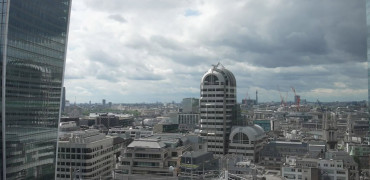It’s just over 25 years until the country must hit its legally binding net zero target, so building owners and operators need to put plans in place to improve their building’s energy efficiency and lower the carbon footprint. This includes planning around the heating, ventilation and air conditioning (HVAC) which is a major consumer of energy in any building.
There are estimated to be over two million commercial buildings in the UK and around 80% of these are already built, so getting them ready for net zero will require some form of retrofit, and that’s where a new whitepaper will help.
‘Considerations for Commercial Building HVAC Retrofit: Setting the Stage for Efficiency and Sustainability’ looks at the work that building owners will need to undertake to prepare their properties for the UK’s low-carbon future.
Retrofitting these buildings will play a crucial role in achieving net zero targets as non-domestic building stock is responsible for nearly a quarter of the UK built environment’s operational emissions.
The time to retrofit is now, not when a building is at imminent risk of becoming a stranded asset.
Don’t get left behind
Buildings that fall behind the increasingly stringent environmental requirements are already proving to be less desirable to tenants.
We’ve written before about the dangers of buildings becoming ‘stranded assets’ that can’t be let and will fail to reach their sale value.
Buildings must meet high standards of EPC (Energy Performance Certificate) rating and failing to do so will result in a less commercially appealing asset for landlords, investors, and tenants.
All commercial building stock which requires an EPC rating is at risk, especially if the building still uses fossil fuel and does not have a plan in place to remove it from site in the coming decade.
However, the EPC rating is just the start as a building could also get stranded because it has not been put on the right pathway to net zero or still plans to use fossil fuels for its heating, which won’t align with the aspirations of current or future tenants.
Yet the longer building owners leave it to upgrade their buildings, the more it is likely to cost in the long run and this is where the new white paper can help.
What is retrofit?
The guide starts with an examination of what retrofit means and how it can be undertaken on different scales, which is important as finding ways to increase energy efficiency and reduce carbon emissions can appear daunting to businesses.
How does retrofitting apply to different buildings from offices to schools and hotels. What about healthcare and retail, data centres and heritage buildings. Retrofit projects to meet future recommended standards will need to reflect the targets and requirements for each sector.
The guide explores the differences between a ‘Light’ and a ‘Deep’ Retrofit, with a light retrofit looking at ways of optimising a building’s current performance, and a deep one needing more fundamental building work.
A light retrofit may involve straightforward things such as adding new control systems or patterns of use to minimise waste. It could also involve very simple things such as ensuring you do have regular service and maintenance of HVAC equipment so that it is running as efficiently as possible.
It could also involve ‘light’ changes to the building itself, such as adding solar shading on the side that spends most of the day in the sun.
A deep retrofit is more likely to involve stripping rooms, floors, or entire buildings ‘back to the brickwork’ and will be required for buildings that need large energy savings to comply with energy efficiency regulations such as MEES.
The cost of retrofit is going to be a major factor of any business, so the guide looks at where to start and how to plan this into your business’s plans for the next five, ten years and beyond.
The first point is to make a start in planning, and this is where data proves so important with the guide focusing on the critical steps from planning to tracking and optimisation.
A whole section is devoted to the considerations needed when considering plant space for HVAC and the importance that different technologies can offer, in terms of reduced footprint versus cost, the importance of the power supply and how to optimise systems
Increasing understanding
The guide sets out six key reasons to retrofit and provides building owners with an understanding of the principles of retrofitting, helping them to plan improvements to their property that suit their budget, timeline, and sustainability goals.
It also supports HVAC contractors who are discussing options with their clients as they join the retrofit revolution for efficient and sustainable buildings.
In addition, the guide includes links to further publications that provide in-depth information on some of the complex issues around retrofit.
Six key reasons:
- Prepare your building for the low-carbon future
- Align with your building’s carbon reduction targets
- Enhance its long-term building value
- Save energy by reducing long-term operational costs
- Future-proof your building to meet demand for sustainable space
- Gain insights into how to continuously improve a building’s performance
Summary
This guide is designed for building owners who want to engage with the process of retrofitting for energy efficiency and improved carbon performance.
By allowing themselves more time to find the best approach for their building, they will be able to plan their priorities instead of having decisions forced on them by changing legislation or financial obligation.
The time to retrofit is now, not when a building is at imminent risk of becoming a stranded asset.
We’ve worked with clients on HVAC retrofits, which have resulted in lower energy use and reduced carbon footprints for heating, cooling and hot water systems.
These clients also benefit from reduced energy costs and better-performing systems.
Dan Smith is Sustainability and Construction Manager




